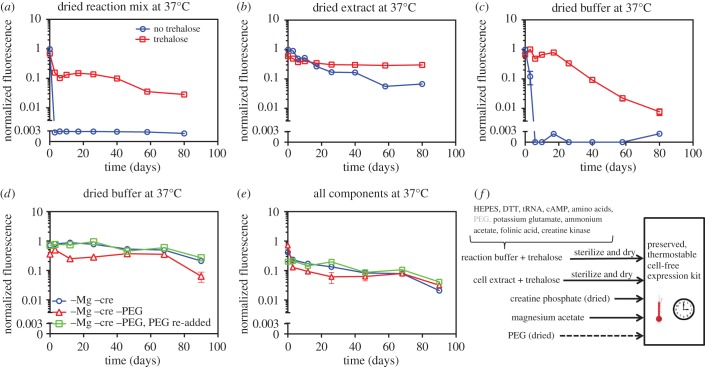Figure 2.
Development of preservation procedure. In all cases, the expression capacity of different reconstituted component combinations was assayed by adding a T7-EGFP expression construct and measuring fluorescence after 5 h of incubation. Fluorescence values are normalized by dividing by the 5 h fluorescence of a standard reaction with fresh reagents. The means of triplicate measurements are shown, with error bars indicating standard deviation. Cases where no error bars are visible indicate that error bars are smaller than the marker. The axis break indicates the threshold for significance above background levels. (a) Aliquots of reaction mixture were prepared with and without trehalose and were dried. At different time points during 37°C storage, water was added to reconstitute dried reaction mixture, magnesium acetate was added and expression capacity was assayed. (b) Aliquots of cell extracts were prepared with and without trehalose and were dried. At different time points during 37°C storage, water was added to reconstitute dried cell extract, fresh reaction buffer was added and expression capacity was assayed. (c) Aliquots of reaction buffer were prepared with and without trehalose and were dried. At different time points during 37°C storage, water was added to reconstitute dried reaction buffer, fresh cell extract and magnesium acetate were added, and expression capacity was assayed. (d) Two variants of reaction buffer were prepared: one omitting creatine phosphate and magnesium acetate and one omitting creatine phosphate, magnesium acetate and PEG. At different time points during 37°C storage, water, magnesium acetate and creatine phosphate were added to reconstitute the two different dried reaction buffer variants. A third reaction buffer sample was created by adding PEG to an aliquot of the reconstituted reaction buffer that was previously dried without PEG. For all samples, fresh cell extract was added, and expression capacity was assayed. (e) Cell extract was preserved and tested with the same reaction buffer preparations as in (d). Thus, all components of the cell-free system were preserved and exposed at 37°C. (f) Summary of the cell-free preservation approach.

